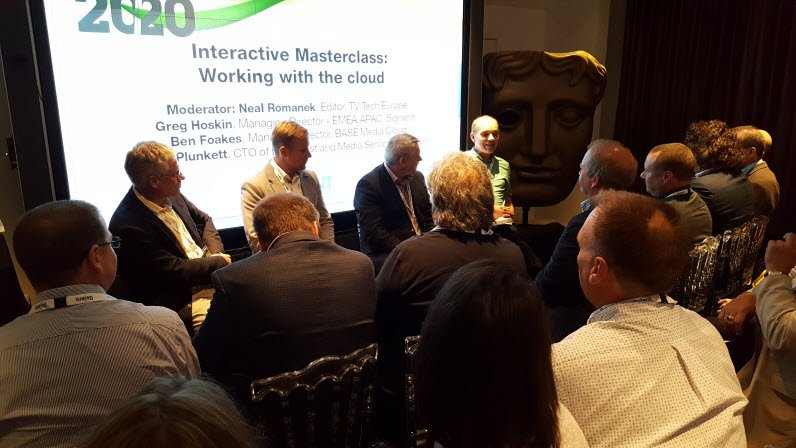The Cloud: it’s not just Another Data Center
One of the interesting things about the cloud discussions I have with many people in the video industry, and one of the myths I often encounter in these discussions, is that because of all the information swirling around (much of it conflicting and cautionary), people are led to believe the cloud is, essentially, just storage. Or more holistically, they can at most imagine it’s a virtualized data center, sitting in somebody else’s facility.
Now if you take that perspective, then the benefits of the cloud and the gains that cloud technology can actually deliver to you, are sure to be overlooked. If that were the case, you may as well just have your own enormous data center; you wouldn’t even need to bother with using Amazon or Microsoft’s cloud services.
Think Differently about the Cloud
If you want the values and benefits that the cloud can actually bring you, your approach to thinking about the cloud has to be different.
This need to think differently about your move to the cloud was the overarching thread running through a Signiant-sponsored panel at TVBEurope 20/20 last week, where I along with fellow industry colleagues Ben Foakes of BASE Media Cloud and Steve Plunkett of Ericsson participated in an interactive masterclass called “Working with the cloud,” moderated by TVBEurope’s Neal Romanek.
The discussion attracted a crowd that seemed to have moved beyond the industry’s early fears of whether the cloud is secure, and instead sought to explore the practical topics of who’s moving to the cloud, benefits of doing it now, and future benefits. And it all came down to changing how people think about what the promise of the cloud can deliver.
Harnessing the power leads to big rewards
Let’s start with those values and benefits, of which scalability-on-demand, paying for only what you use, enormous capacity theoretically without a ceiling, and automated processes to make this all happen are just a few.
The immediacy of how you can feel the effect of all of these in your facility, though, may be the most striking. Think about transcoding as an example; this is emerging as a powerful way to take advantage of cloud processing for video production workflows.
Currently a media company or production team may capture dozens or even hundreds of hours of footage on a project. Now, they probably bundle up all the tapes or disks and bring them down to the facility and buy the transcoding for a fee, either for quantity of footage or for equipment time used. In the new cloud world, they could just “burst” whatever spare capacity they need to acquire at that moment without interrupting any of their broadcast processes.
These types of models are where the cloud really starts to come into its own as an on-demand, additional facility for the customer to move forward.
Having nearly unlimited storage is one value proposition, and it’s a really good one. But what processing video in the cloud is doing is closing the gap between the infrastructure, and the people who have to interact with it.
This was reinforced by Steve Plunkett on the panel:
“When you think about how to take advantage of the cloud, you can’t just think ‘how can I do this same thing, but in the cloud, so I can have more scalability or more storage or more flexibility?’ You have to really go through an understanding about what’s different, how does it work differently from what I do, what do I want and need to do differently to take advantage of it?”
Think about transcoding huge amounts of UHD video. Does it make sense to rent one machine for a thousand hours, and get your job processed 42 days later – in Steve’s terms, “long after the rights window has been reached?”
Or instead, rent one hour of a thousand Amazon AWS compute units processing concurrently? When you start thinking about that parallel for processing media, you can do really interesting things.
Start with the process
You can easily see the massive benefit to your workflow with just this one example – but it does require you to think about your processes differently first.
You’re not just replicating what you do in one place, over to another. You’re analyzing what’s possible, and seeing how it makes sense in making your workflows more efficient.
Some media companies think “We can make money, or save; in any case, the future’s better, so we’re going to make the jump.” Other ones think “it’s going to cost me five times as much so I’m not going to bother.”
The latter perceive the capabilities to be just like a traditional data center in the cloud, only more expensive – and therefore they can’t do it that way. As one of the audience members articulately stated, “You can’t simply say, ‘I want to be in the cloud,’ and suddenly you’re in the cloud.”
Even as everyone present recognized that cloud processing will become mainstream with its incredibly fast performance, capacity and efficiency, a point of frustration will continue to be moving media there from its point of production. That’s a problem Signiant has already solved for our clients, who are ahead of the curve in designing their workflows for the new world.
You’ve got to think differently. And those who think differently become more agile, gain the benefits, embrace the change, and move into the future.



